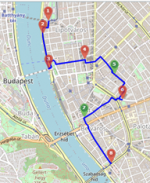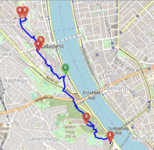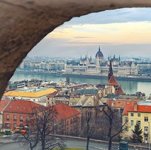Chapter 243: Sep 26 - Vienna, Austria (1) - Part Three
My third excursion of the day was a one-stop exploration of Schonbrunn Palace. Or should I say it was scheduled to be a one-stop. Due to the protestors we were diverted to the Schatzkammer (Imperial Treasury) for about 90 minutes. The Schatzkammer holds what is considered to be the greatest treasury collection in the world. Located within the Hofburg complex, the current structure has been in place since 1983. The entrance is located at the Swiss Courtyard which took us away from the media that were following the protestors. While we were Schatzkammer we got a tour of the Habsburg Empire which date back over 1,000 years. Among the beautiful items there is a sword that is believed to have belonged to Charlemagne (Charles the Great, aka Charles I, King of the Franks), the crown of the old Holy Roman Empire, and even the legendary Agate Bowl which, for centuries, was tied to the story of Arthur’s court and the legend of the Holy Grail. It was an incredible blend of Austrian history with just enough "wow" factor to keep my people from getting bored and anxious that included fantastic embroidery, religious relics, and pieces of royal jewelry.
Finally it was on to Schonbrunn Palace (German: Schloss Schönbrunn), a former imperial 1,441-room Rococo summer residence in modern Vienna. One of the most important cultural monuments in the country since the 1960s, it is one of the major tourist attractions in Vienna. Schönbrunn Palace as the tourist destination is attended by nearly 3,000,000 visitors in annually. The whole Schönbrunn complex with Tiergarten Schönbrunn, Palmenhaus, Wüstenhausand the Wagenburg, accounts for more than five and a half million visitors. In addition to tours and tour packages, many classical concerts featuring the music of Mozart and his contemporaries can be enjoyed with the added benefit of more time in the spectacular halls, Orangerie, or Schlosstheater.
We had a separate guide who took us on a tour of the home of the Hapsburg Dynasty, built to rival the sprawling Château de Versailles. In 1569, Holy Roman Emperor Maximilian II erected the original hunting lodge here and called it Schönbrunn, meaning “beautiful spring.” In 1775, Empress Maria Theresa, the only female ruler of the Hapsburgs, added the neoclassical Gloriette colonnade so she could have sweeping city views. We saw the imperial apartments and grandly furnished rooms where Maria Theresa resided, and learned about her extraordinary reign which featured many military campaigns and domestic reforms in medicine, education and civil rights. There was also free time to explore the formal gardens which meant work for Vit and I as we had to separate to keep track of everyone.
Schönbrunn Palace was Empress Maria Theresa’s favorite palace, and she made it the social and political center of her empire, beginning in 1740. We also visited the rooms occupied by Emperor Franz Joseph and his empress, Elisabeth (known as Sissi, she was enormously popular in her day). Franz Joseph restored the state rooms to their rococo splendor, but his private rooms reflect his rather severe nature, making for an illuminating contrast.
Luckily, all of the members of that excursion were also scheduled for the last one of the day, a Heurigen Evening. I wasn’t quite sure what to make of the excursion while I read about it last night in my paperwork, but it turned out to be the perfected ending of a lovely day (sans the protestors). Essentially it is Vienna’s version of a celebratory wine-tasting at a local vineyard.
We met our guide, a new one, and drove through the streets of Vienna to the Grinzing district. During this annual Austrian tradition, locals gather amid a festive atmosphere to mark the bottling of the season’s vintage. The glasses are always full of the season’s first pour and a spirit of
gemütlichkeit, or good cheer, fills the air. Our guide explained that experiencing this custom is key to an understanding of Austria and the importance of viticulture to its people.
Once strictly the domain of vintners and day laborers who put wines on the tables of monasteries and Vienna’s bourgeoisie, today that district is a thriving area of taverns with a rich history. There was wine (of course), snacks (thank goodness because a man may not live by wine and chocolate alone), and toe-tapping traditional music performed live.
Vit insisted on at least splitting something that did not have sugar as its main ingredient followed by a dessert of original Sacher cake. Yum. Afterwards I was rather bold and decided to have another cake since it’s not likely that I’ll be here any time soon again. I chose the cake I was looking at after puzzling out its name; nearly as delicious as a dessert in and of itself. I hit jackpot. It was divine and it contained a hidden surprise inside.
Weihnachtenkugeln cake (Christmas bauble cake) did look like a Christmas bauble or as we call them in the US, a Christmas tree ball ornament. It reminded me a bit of a
Kinder surprise chocolate egg because there was a thin layer of white and milk-chocolate and inside a surprise. A chocolatey cream and something white and very tasty. I first thought it was marzipan, but it was actually apple! The chocolate shell tasted of gingerbread. Was it the red dust that gave it that o-so-Christmassy taste? I don’t know but I loved it! Vit snuck a picture of my first bite which he sent it to Charlie and I could hear him laughing even though it was just an email.
I finally got my very satiated group back to the ship and then helped Vit hurry into a clean uniform. I got a kiss that tasted like even more chocolate and he asked me to please put away our purchases so he wouldn’t trip on them and wake me up when he came in late. And what a lot of packing I am looking at. There is barely room left under the bed. We need to get choosey from here on out. I know I keep saying that but it’s true.
First, I need to find additional packaging for the Viennese snow globe I purchased nearly first thing this morning. How on earth I am going to get it home? Perhaps I will have to carry it on the plane except there is the problem with liquid limitations. There is no way you get out of Vienna in the winter without having stumbled over a snow globe. More than 115 years old Wien’s most popular decorative gift is still produced in the Perzy family’s manufactory in the
17th district. While the snow globe is available in various sizes you can let it snow on key landmarks, mountains and villages, animals, cakes, Johann Strauss and Empress Sissi, and even expressions of love. I found one that snowed on a violin and couldn’t resist it. Or should I say refused to resist it.
Along with the globe came a flyer with some interesting facts about them. It is thought that snow globes originated in France in Europe, with the first known record being a globe of water and white powder, with a man holding an umbrella, which was on display at the Paris Universal Expo in 1878. Snow globes were first patented in the year 1900, in Austria, by Erwin Perzy, a mechanic of surgery instruments, who is believed to have thought of the idea whilst attempting to increase light bulb luminescence. The production and demand of snow globes increased between the 1920s and the 1940s, with the rise of cheaper production methods and materials. Although snow globes are commonly used for ornamental purposes, in some cases, they were initially purposed for and used as paperweights. To prevent the liquid inside a snow globe from freezing during cold temperatures, an antifreeze such as glycol, is often added to the water, while glycerine or another ingredient is sometimes added to slow the movement of the flakes in the liquid.
Polina spotted the Viennese wines before anyone else did at the market and then it was like hyenas after a fresh kill. I saw Polina’s look of determination to wade in, and I stayed as far out of the maelstrom as possible. Viennese wine is not like your typical Italian or French wine. Viennese wine enjoys a certain kind of cult status among wine connoisseurs and is typically served in more gourmet style restaurants, or so it was explained to me. Vienna actually dedicates about 700 hectares (1,729.7 acres) of land within its city boundary for the production of wine, which is the largest in the world. Since the 1600’s, pub culture grew in Vienna and now Viennese wine is part of the culture.
“Oh my gosh Polina,” I said trying not to laugh so anyone else would notice.”
“You will thank me later when you present this to your man.” She was looking so triumphant I couldn’t help it. I got a fit of the giggles. Not just at her but at the very satisfied looks on our excursion members, and the every bit as satisfied looks on the clerks and wine sellers. Oh my word. I want to ask Yegor for a copy from my body cam although it might be one of those “you had to be there” moments.
While Polina guarded the wine – I added a bottle for Henry to try and perk him up – I hit up a stall that sold Vienna’s famous apricot jam. Chief Gunder, a man who sees himself as a bit of a gourmand foodie, told me that if you’re looking for something truly unique and delicious that is very much Austrian, then apricot jam is a good economical item to choose. Traditional Austrian apricot jam is called “Wachauer Marille” and is grown in the Wachau Valley and is romantically said to be ripened by the midsummer sun. Of course, once I started with apricot I couldn’t stop there, especially as the stall was selling Staud’s
[1] brand. I wound up having to have it delivered to the ship. Vit could only blink … and then wipe his mouth and struggle to say which jar he wanted me to keep out while I packed the others for sending home. In addition to the apricot there was strawberry, blackberry, raspberry, wild blueberry, sour cherry, gooseberry-kiwi, elderberry-plum-apple, wild lingonberry, plum, tropical fruit mix, traditional fruit mix, rose hips, pears, and red currants. I got a sampling of their wine jellies as well. Chutneys included Apricot, Fig, Apple, and Mixed Fruit. There were jars of fruit in syrup and jars of pureed fruit. There were jams made with brandy. There were syrups and punches like the Jamaican Rum and Blood Oranges as well as several others. But the pièce de resistance were the chocolate jams. Yes, I said chocolate jams.
Polina and I looked at each other and said, “Yegor.” It caused us both to laugh and drew the attention of some of the tour members as well. One woman in particular said, “Oh my gawd, I am so getting some of those for when I’m jonesing. Rockford [her partner] probably’ll wonder why I didn’t get more if it means I don’t turn ‘cudda on him once a month.”
After I explained the reference, Polina got a thoughtful look and tossed in a couple of more to her purchase causing me to want to giggle all over again. But who can resist flavors like Chocolate-Banana Roulade, Chocolate-Raspberry Macarons, Chocolate-Sour Cherry Brioche, and Chocolate-Coffee Mousse and Orange?
I didn’t buy any but did help a few personnel purchase a few small pieces of Viennese porcelain. Known as some of the best in the world, it is made with a hard paste rather than soft. It is so famous that it has been used as diplomatic gifts given between countries. Elaborate design and decorations often can be found on older and more expensive pieces, but contemporary designs and patterns supposedly make a great gift for those visiting Vienna … and I suspect as the traditional diplomatic gift.
Jams aren’t the only delicacy that we bought. Pumpkin seed oil is not too expensive as such things go and Chief Gunder had recommended it within Yegor’s hearing. The pumpkin seeds are crushed, roasted, and then pressed and the oil goes great with food in either a sauce for lamb or beef and even in salad dressings. Some people even like to put in on vanilla ice cream. Uh, I am food adventurous but I don’t think even I could imagine that pairing.
And of course there was the artisanal chocolate that is taken so very seriously in Vienna. Much like the art of porcelain and winemaking, the art of chocolate is something that has been passed down for generations. Chocolate was a big deal in the imperial courts where, essentially, only those involved in the upper classes could afford it. Vienna is now home to tons of chocolatiers all with their own delicious brands. I sampled a bit too much all morning long and I’ll probably pay for it with a zit, but I’m not complaining, at least not yet.
I nearly busted out laughing again when someone asked me to help her navigate a transaction for a traditional dirndl dress. Polina looked at me and said, “Nyet. Not even for Yegor and one of his fantasies will I squeeze into
that.”
Thank goodness that a vendor of Mozartkugel (“Mozart ball”) distracted me. It is a round-shaped, dark chocolate-coated candy, stuffed with pistachio marzipan and nougat that has been the signature delicacy of Salzburg, the hometown of great composer Wolfgang Amadeus Mozart (after whom it is named), since the late 19th century. Original Salzburger Mozartkugeln are still made by hand at the original confectionery run by the Fürst family. I didn’t want to pay the price for an original brand, but there were plenty of more economical knock offs that were just as tasty.
Then there were the Austrian cookies. Oh. My. Among the most notable of them are Ruger Wafers – delicious, crisp, gourmet delicacies made in the Austrian Alps in accordance with the old-time recipes, using top-quality ingredients combined with the latest technology, which creates some truly unique, aerated vanilla-flavored cream fillings. Other handcrafted Austrian cookies we saw (and tasted broken samples of) included: Linzer Cookies - spiced with a touch of cinnamon, lemon and orange zest, complete with a raspberry jam, lemon curd, and apricot jam filling; Viennese Chocolate Kisses - made with hazelnuts and dark chocolate; Butter Cookies - a delicious treat with little sugar glaze dots; and Vanilla Tea cookies - soft, tender hazelnut butter cookies coated in vanilla sugar or dark chocolate.
It being the most money that I had expended in some time, I expected Vit to squeak a bit. Instead he seriously asked me if I was sure that I had purchased enough. All I could do was go off in gales of laughter and pull him down onto the bed with me for a moment for a kiss of approval.
“You like?” he asked with a grin.
“Very much.”
“Is goot,” he said, mimicking Chief Gunder, sending me off into more laughter. I think I wouldn’t mind so very much if he wakes me up when he comes in. Tomorrow is a second day in Vienna. First comes nature and afterwards I will see if there is another excursion for me to guide. I’m not sure yet. It depends on whether Chief Gunder has recovered from today. LOL
[1] Feinste Verführung aus Wien von STAUD'S



